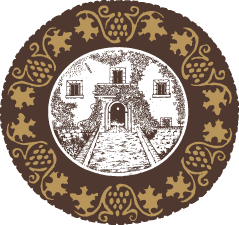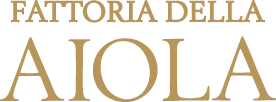Noble traditions of Tuscany
A fascinating blend of old traditions and innovations
Today Aiola is a winery in the heart of the Chianti Classico, both geographical and wine zones. The 36 ha of vineyards where Chianti Classico wines are born, are protected by oak- tree and chestnut groves. In line with the Chianti Classico zone rules, Sangiovese forms 80% of all grapes we grow, other varieties include autochthonous Colorino, international Merlot and Cabernet etc. Since 1947, Fattoria della Aiola is a member of Chianti Classico Consortium, so the whole process of Chianti Classico production is following its standards.
Aiola is situated about 10 km away from Siena, on a gently winding panoramic road leading from Vagliagli to Radda. Once upon a time a mighty castle protecting access to Siena, then a noble summer residence in the late Renaissance, today Aiola preserves important traces of a medieval fortress.
The image of "Gallo Nero" - Black Rooster, the quality trademark of Chianti Classico Consortium, adorns our wine bottles and straw-covered flasks — "fiaschi".
Chianti Classico is our core wine, but our portfolio is varied: it includes IGT wines — blends of Italian and international grapes, produced in limited quantities. Aiola is famous for its grappa, produced from Sangiovese pomace, as well as for cold-pressed virgin olive oil made from our own olives.
The passion for wine and creativity are the driving forces behind everything we do: new wines bearing the Aiola logo and brand are made at the facilities completely renovated in 2015. Our ambitious growth plans foresee planting new vineyards in the years to come.
Wine is about people! Paolo Salvi, a true Master of Chianti Classico and one of the best oenologists in Italy, is at the helm of the winemaking team. His inspiration and our great team’s work are behind numerous rewards and high scores from critics and international competitions. In 2015, the single vineyard "Cancello Rosso" was qualified as Gran Selezione, top quality level of the Chianti Classico.
Chianti Classico is our core wine, but our portfolio is varied: it includes IGT wines — blends of Italian and international grapes, produced in limited quantities. Aiola is famous for its grappa, produced from Sangiovese pomace, as well as for cold-pressed virgin olive oil made from our own olives.
The passion for wine and creativity are the driving forces behind everything we do: new wines bearing the Aiola logo and brand are made at the facilities completely renovated in 2015. Our ambitious growth plans foresee planting new vineyards in the years to come.
Wine is about people! Paolo Salvi, a true Master of Chianti Classico and one of the best oenologists in Italy, is at the helm of the winemaking team. His inspiration and our great team’s work are behind numerous rewards and high scores from critics and international competitions. In 2015, the single vineyard "Cancello Rosso" was qualified as Gran Selezione, top quality level of the Chianti Classico.
Chianti Classico.
The territory
Flanked by two great cities of art, Florence and Siena, the territory of Chianti Classico is divided into 9 subzones. Our vineyards are situated on the border between two of them — Radda in Chianti and Vagliagli of Castelnuovo Berardenga — getting the best of each of their distinctive characters.
Denominazione di Origine Controllata e Garantita
Black Rooster that you will almost always see adorning bottles of Chianti Classico, was a historic emblem of Lega del Chianti, a XIV century military and political institution of the Florentine Republic. The rules of Chianti Classico DOCG, a designation of the highest quality standards, require wines to be made with at least 80% Sangiovese grapes, while 20% can be other red varieties, local or international.
Aiola Chianti Classico wines are made with at least 90% Sangiovese and varying shares of Colorino, an autochthonous grape, and Merlot.
Aiola Chianti Classico wines are made with at least 90% Sangiovese and varying shares of Colorino, an autochthonous grape, and Merlot.
The History of Chianti Classico
1384
A Black Rooster against golden background is adopted as the symbol of the Lega del Chianti
1716
The Grand Duke of Tuscany Cosimo III Medici sets the boundaries of the production zone of Chianti wine, today Chianti Classico
1932
The wine produced at the historically defined territory Chianti territory gets the distinctive designation "Classico"
1984
Chianti Classico becomes DOCG, Denominazione di Origine Controllata e Garantita
1398
The first official document mentioning "Chianti" (now Chianti Classico) as a reference to wine.
1924
The first Consortium for protecting a typical wine and its brand is born in Italy with Black Rooster as its symbol.
1947
Fattoria della Aiola becomes a member of the Chianti Classico Consortium.
1996
DOCG rules evolve allowing Chianti Classico wines made from up to 100% Sangiovese.
1384
1924
2005
2013
The leggend of the Black Rooster
They decided that two horsemen should depart at the same time from Siena and Florence and travel towards each other. Where the horsemen met the borders would be drawn. The riders should start at dawn and the exact departure time in each city was to be defined by the crow of a rooster, as town clocks could hardly be synchronized. So, the choice of the right rooster was crucial, more important than the steed or the rider.
The black rooster has actually been the symbol of the entire Chianti for many hundreds of years. The legend passed from generation to generation tells us about the ongoing rivalry between Florence and Siena in Medieval times over who should rule the hills of Chianti. In fact, so much blood was shed that they finally decided to settle this once and for all, in an incredibly unique way.
The Sienesi chose a white rooster and fed him well hoping for a vigorous morning song. The Florentines, instead, chose a black rooster and kept the poor bird hungry and in a dark shed.
On the fateful day of the race, the Florentines opened the shed and the desperate and hungry bird started to crow well before dawn, hoping for some food. Their horseman started riding much before Siena’s horseman who had to wait until the well-fed white rooster wakes up with the first rays of the sun and starts greeting it with his song.
The Florentine horseman made it to almost 12 kilometers outside the Siena walls before he was met by his counterpart. They met at Fonterutoli, and thus practically all of Chianti territory was claimed by Florence, centuries before Siena itself passed under the Florentine rule. This is how the black rooster became the symbol of Chianti up to this day!
www.chianticlassico.com (c)
On the fateful day of the race, the Florentines opened the shed and the desperate and hungry bird started to crow well before dawn, hoping for some food. Their horseman started riding much before Siena’s horseman who had to wait until the well-fed white rooster wakes up with the first rays of the sun and starts greeting it with his song.
The Florentine horseman made it to almost 12 kilometers outside the Siena walls before he was met by his counterpart. They met at Fonterutoli, and thus practically all of Chianti territory was claimed by Florence, centuries before Siena itself passed under the Florentine rule. This is how the black rooster became the symbol of Chianti up to this day!
www.chianticlassico.com (c)
Aiola is firmly rooted in the Sienese territory, the Aiola castle had for centuries protected the road to Siena. Our vineyards are just below Vagliagli, a medieval town a few kilometers to the north of Siena. The town’s name is derived from "Vallialli" - a valley belonging to a Signor Allius.
We are Aiola
- Paolo BarzagliProduction manager
- Nicola VangelistaCellarman
- Donatella GuerriniLogistics manager
- Maya BeckHospitality & Wine tours
- Natalia MeylunasBusiness Development
- Bianca SchumannPublic relations
- Davide ToschiDomestic sales manager
- Svetlana KuskovaMarketing
- Alessandro BisogniWinegrower
- Alessandro TrombiniWinegrower
- Ramiska AdemiProduction team
- Iso AdemiWinegrower
Contact us
Office:
+39 0577 22615
info@aiolawines.com
Wine shop, Wine tasting booking:
+39 0577 322615
booking@aiolawines.com
+39 0577 22615
info@aiolawines.com
Wine shop, Wine tasting booking:
+39 0577 322615
booking@aiolawines.com
Click to order








